Vacuuming Disk Safe enables you to reduce the on-disk size. Block Stores are vacuumed in-place when the Vacuum function is selected by a user.
| Notice Vacuuming may also increase the internal fragmentation and make the Disk Safe slower in the future. |
About Vacuuming
The Disk Safe has a fixed size of 32 KB pages. The pages are indexed using B-Trees and each page is packed with block-level deltas. As you merge old recovery points, some deltas can be discarded.
Deltas can be discarded when merging an old recovery point into a newer one when any one of the following conditions are met:
1. The file system (e.g., NTFS or Ext4) is no longer using the block (you will likely have deleted some files and the associated blocks may not all have been re-used by the O/S).
2. The block has become overwritten (you changed a file).
3. You have re-sized your file system to make it smaller, and the blocks are simply no longer used.
When you merge old or unwanted recovery points, it is normal for the on-disk size of the Disk Safe files to not change or get smaller. Normally, this is not an issue and you can let the Disk Safe manage its on-disk footprint, automatically reusing the freed storage for new block-level deltas.
If you delete a device or disk volume from the disk safe, its space is automatically deleted because each disk has its own block-level delta store (.db file). When you delete a disk from the Disk Safe, this file is deleted.
When to Vacuum
If one of the following events occurs and you need to save as much disk space as possible, then you may want to consider vacuuming your Disk Safe:
1. You deleted a large number of recovery points. For example, you used to keep the last 100 Recovery Points but now only keep 5.
2. You greatly reduced the amount of files or data you are replicating. Maybe you protected the whole C: previously, and you now have changed your policy so that you exclude C:\Windows and another large directory, and the old Recovery Points still containing the folders you excluded have been merged away. Another example is that your D: drive had 100 GB of files on it but now only contains 10 GB.
When any one of these events occur, there may be a lot of empty, unused space in the Disk Safe .db files. You can use the "vacuum" action on Disk Safes to shrink the on-disk footprint of the Disk Safe .db files.
When you run a vacuum, the Disk Safe is taken offline, meaning the Disk Safe cannot be used by policies or for restores. The vacuum attempts to shrink the Disk Safe .db files as much as possible by relocating empty pages to the end of the file and full or partially filled pages to the front of the file. At the end, the file is truncated by the number of empty pages that existed in the .db file.
| Best Practice Avoid vacuuming your Disk Safe and certainly do not do it on a regular basis as the vacuum process, by nature, causes unavoidable internal fragmentation of the Disk Safe files which can impact performance. Normally, the Disk Safe file is organized as optimally as possible for fast indexing of the B-Tree to locate block-level deltas as needed for file restores and when writing new deltas for replication. By relocating pages in the file to truncate it the ordering become less optimal. |
How to Vacuum Disk Safes
Follow the instructions below to vacuum a Disk Safe in CDP.
1. Click "Disk Safes" in the Main Menu to access the "Disk Safes" page.
| Standard Edition | Enterprise Edition | Advanced Edition |
|---|---|---|
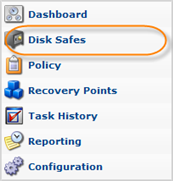 |
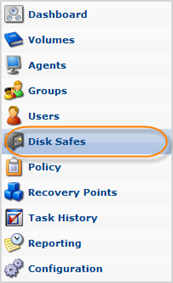 |
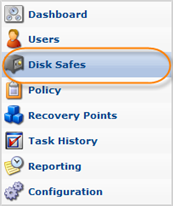 |
2. In the "Disk Safes" list, find the Disk Safe you need and click the "Vacuum" icon located in the "Actions" column next to the appropriate Disk Safe.
| Standard Edition |  |
|---|---|
| Advanced Edition |  |
| Enterprise Edition |  |
| Tip To find a Disk Safe, you can use the Basic and Advanced List Filters. See Customizing the Disk Safes List. |
3. After clicking the "Vacuum" icon, a warning window opens. Confirm your request to vacuum the selected Disk Safe by clicking "Vacuum."
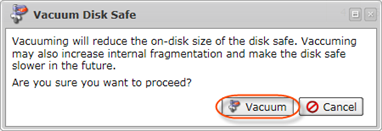
4. You will receive a notification that the Vacuum Task has been scheduled. Click "OK." The Task will run immediately after its creation.

| Tip The Task results can be sent via email as a Report. See Reporting. |
5. The new Task appears in the "Reporting" list. The properties are shown in the grid.
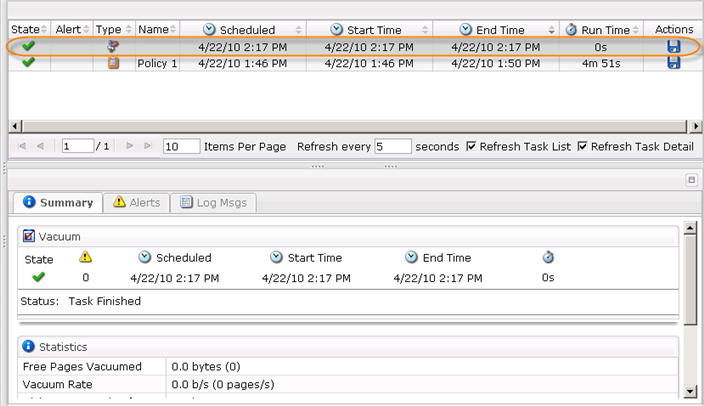
| Tip You can also vacuum Disk Safes using the "Disk Safes" tab of the Agent "Details" Pane. This screen provides the same functionality as the main "Disk Safes" screen. See more information in Accessing Agents. |
